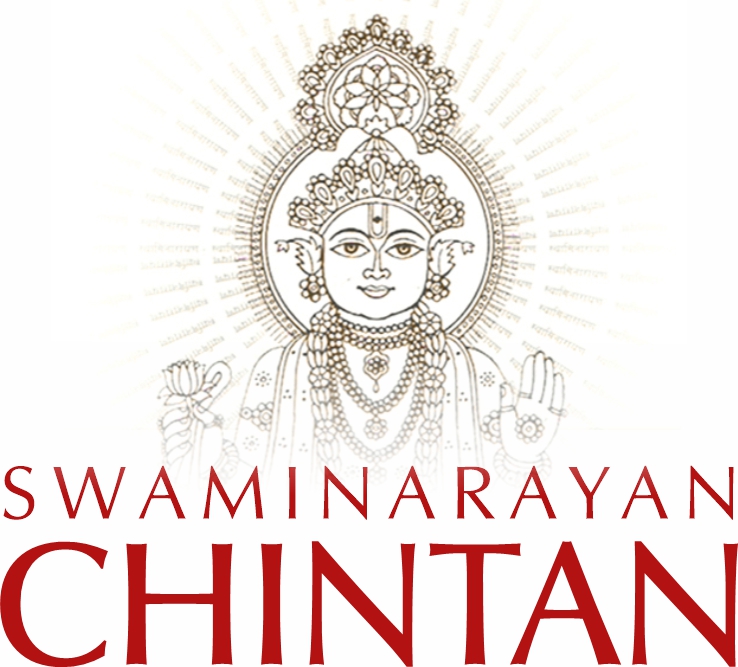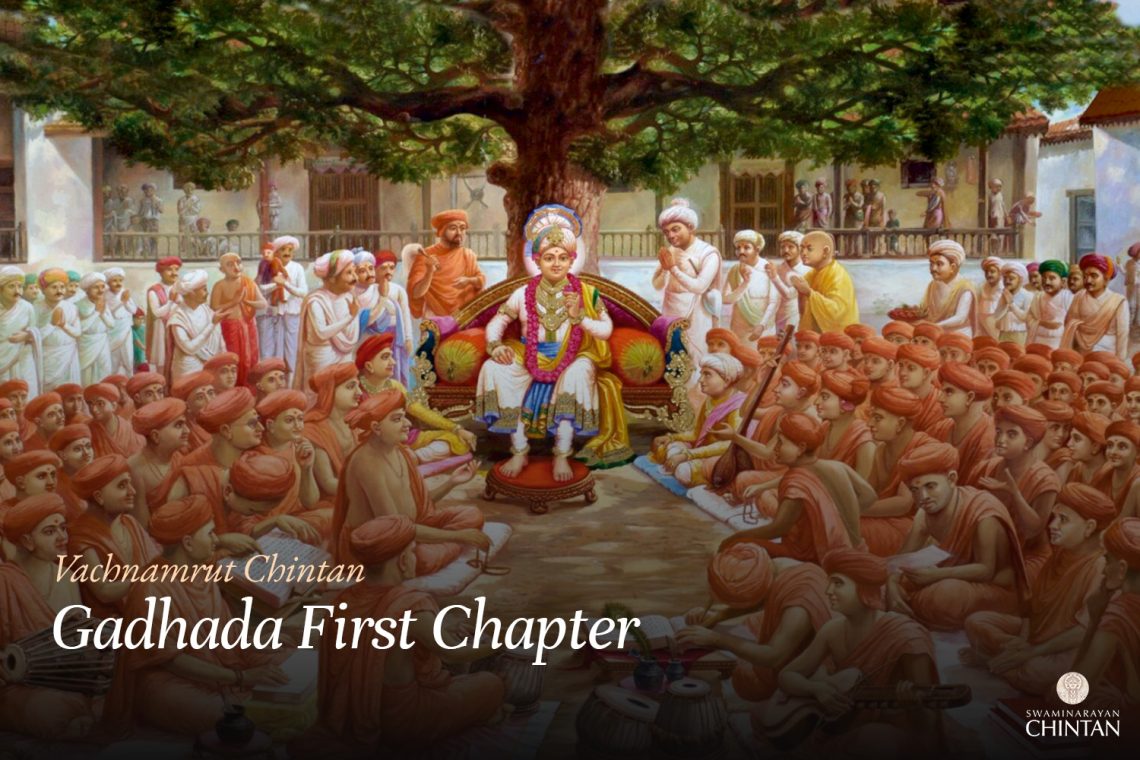Central Insights:
- Knowing bhagwan by four scriptures
Key Points:
- One should accept the knowledge of the subject from the scripture, which contains the priority of that respective subject.
- The greatness of bhagwan must be understood by four scriptures.
Explanation
The katha of Moksha Dharma was being read in the courtyard of Dãdã Khãchar, arranged by Shreeji Maharaj. In the katha, one topic came up that if one understands the form of bhagwan by four scriptures Sankhya, Yog, Vedant and Panchratra, then he is considered as a person with complete knowledge . Then, Muktanand swami asked: O Maharaj! How to understand bhagwan by those four scriptures? And if not understood by those four scriptures then what is deficiency in that?
Then Shreeji Maharaj said: Sankhya scripture counts twenty four elements and bhagwan to be twenty fifth. Twenty four elements cannot do anything without bhagwan, thus he is counted with those elements. Thus, by inherent practice, Jiva cannot be understood separately. Mostly, elemental discussion has been done. Therefore, if Jiva cannot be understood separately then means are for whom? That is a flaw.
While Yogic scripture is one step ahead from Sankhya, and counts Jiva-Ishwar to be twenty fifth, separate from twenty four elements, and bhagwan to be twenty sixth and counts him with divine form (with human-like shape yet divine). It says to count our souls separate from twenty four elements and to meditate on bhagwan who is twenty sixth. It shows bhagwan to be situated at one place (having a proper shape of his divine form or confined, not universal). Otherwise, meditation cannot be done. Meditation naturally believes in compression or confination of space which is a flaw.
While Vedant scripture, especially ‘Shushk Vedant’, counts bhagwan as reason of all, omnipresent, base of all, nirgun (without qualities), niranjan (spotless or blemless or pure). It represents bhagwan as a formless which is the flaw of this scripture.
While Pancharatra scripture especially represents incarnations, abodes, splendour and procedure of devotion of idols of deities. The flaw is to not understand the divineness of bhagwan and spotting human-like nature in him.
Thus, Jiva is not considered separate according to Samkhya scripture. If it counts Jiva twenty fifth then bhagwan is also twenty fifth. Thus the flaw is that it makes both identical. In yogic scripture, if bhagwan is considered with a particular form then he is misunderstood to be bound to one place. By Vedant one understands bhagwan formless. By pancharatra, he is misunderstood with human-like nature. One scripture can remove the flaw of another then there is no loss and bhagwan is understood as it is. In reality, sankhya is a scripture for purification. While vedant is a scripture to understand the greatness of bhagwan. Pancharatra is for devotion and to serve bhagwan. The subject which is dominant in a particular scripture, that scripture should be considered more valid only for the particular subject. But, if one point is more valid from a particular scripture then it cannot be considered as valid for all.
In scriptures, it is called ‘ तटाकोप न्याय’ — taṭākopa nyāya, For example, there is a lake containing pure and clean water but at the bank there are algae, frogs also. Water can be used and praised but only for drinking. It is not necessary to include algae and frogs in praise. Similarly, for the purification of Jiva, tricks of sankhya are good, but that opinion should not be equally taken valid for bhagwan as well.
One must be aware, especially, from the flaws that maharaj showed. Then it can be useful in the path of salvation. The yogic process is very tight. If one follows this method keeping bhagwan in target, then it provides benefits. While the priority of vedant is on showing the greatness of bhagwan. If one worships bhagwan keeping greatness in the target then gets benefits. Pancharatra scripture is valid for bhakti. Thus, tricks for the bhakti should be taken from it. Bhagvan gets pleased soon. The drawbacks mentioned in Vachanamrut for each scriptures must be eliminated respectively. Therefore, with the process of sankhya one must believe soul different and pure from elements and meditate on the divine form of bhagwan by the yogic process, and his greatness must be understood from vedant. While for pure love-bhakti and service must be done according to pancharatra. Then he is a person with complete knowledge according to Maharaj, otherwise he is incomplete in knowledge.
Glossary
| Sankhya – A philosophical system identifying God as the 25th element It emphasizes detachment from the Panch Vishay and realization of the soul separate from the 24 elements. However, it does not distinguish between Jeev and Ishwar clearly. |
| Yog – A philosophical system placing God as the 26th element with form Yog recognizes God’s form and prescribes meditation on Him. But it can lead to a limited view of God, not recognizing Him as Antaryami (omnipresent). |
| Vedant – A philosophy describing God as formless, all- pervading, and Nirgun Vedant views God as the ultimate reality but often ignores His divine form with attributes like hands and feet, thus failing to fully realize Him. |
| Panchratra – A scripture focusing on devotion to incarnations of God, especially Vasudev, Sankarshan, etc. It promotes bhakti but may see incarnations with human limitations if not combined with other scriptures. It lacks full realization of God as flawless and omnipresent. |
| Moksha Dharma – The path to liberation as described in scriptures Refers to duties and conduct that lead to liberation, including study of scriptures and practicing righteousness. Part of the four- shastra model. |
| Shushk Vedant – Dry or barren Vedant Refers to a formless-only interpretation of Vedant, rejecting God’s form and Bhakti; causes fall from true devotion. |
| Tattva – Fundamental element or reality Refers to principles such as the 24 elements, the soul, Ishwar, and ultimately God, who transcends all Tattvas. Used to discern truth. |
| Jeev – The individual soul Considered distinct from body, senses, and Maya; Jeeva is the conscious knower and doer, yet not independent without God’s support. |
| Ishwar – The cosmic controller or deity who governs creation Considered superior to Jeev but still included in the realm of elements in some systems. True Ishwar is a servant of the supreme God. |
| Nirgun – Beyond the three gunas (qualities) of Maya God is Nirgun in essence—not affected by Maya—but still has divine form and qualities. Misunderstanding Nirgun as formless leads to philosophical error. |
| Niranjan – Unaffected by Maya A title for God signifying purity and transcendence over illusion. This is aligned with Vedantic understanding but needs to be harmonized with God’s form. |
| Bhakti – Devotion Described as the means to liberation; should be supported by knowledge, detachment, and Dharma to avoid downfall. Highest when directed purely to God. |
| Darshan – Vision or realization In this context, it implies direct experience or understanding of God’s true form through all four scriptures. |

